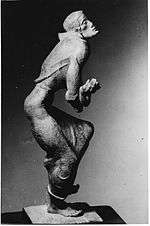Jacob Brandenburg

Jacob Brandenburg (Hebrew: יעקב ברנדנבורג) (1899- December 2, 1981) was a Polish-born Israeli sculptor.
Biography
Jacob Brandenburg was born in Stawiski, Poland. He and his sister Rachel were orphaned in early childhood. He was sent to study at Lomza Yeshiva.[1] He planned to seek rabbinical ordination, but was forced to leave due to ill health. In 1920, Brandenburg moved to Germany and enrolled at the Berlin School of Art in Charlottenburg. He studied under Hugo Lederer and Hermann Struck. In 1934, he immigrated to Palestine and settled in Jerusalem, where he worked as a stonemason[2] and taught art.
Brandenburg was married to Tehila, a children's nurse. They had no children of their own.
Art career

Brandenburg sculpted in wood, stone, clay and plaster, and was inspired by German expressionism [3] Biblical themes and animals were major motifs in his work. Israeli art critic Gideon Ofrat wrote about Brandenburg’s wooden lion in the collection of Haifa University, describing it “old and tired,” compared to Melnikov’s roaring lion at Tel Hai. Brandenburg’s lion is “more spiritual and more human, but stooped and melancholy. It is the Lion of Judah lamenting two thousand years of suffering and exile, and above all, the Holocaust. [4]
Awards and recognition
In 1940, Brandenburg won the Dizengoff Prize. In 1966, he published a book about his biblical-themed sculptures, "The Bible in Sculpture and Painting."
See also
References
- ↑ ’’The Bible in Sculpture and Painting,’’ J. Brandenburg, Ari Ibn-Zahav, Jerusalem, 1966
- ↑ בין בורגנות לאמנות פלסטית בתקופת היישוב
- ↑ ’’Hayom’’, Miriam Tal, January 20, 1967, p. 5 [in Hebrew]
- ↑ כפיר, לביא, שחל ושאר אריות Gideon Ofrat: Lions in Israeli art